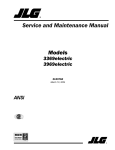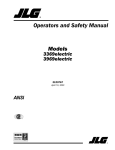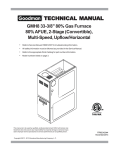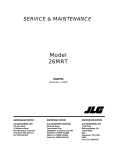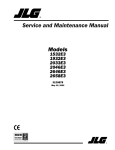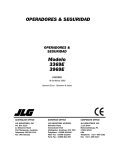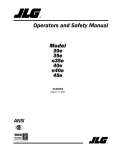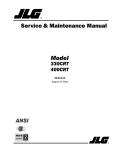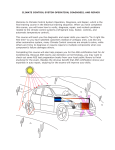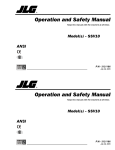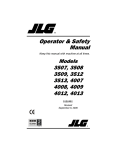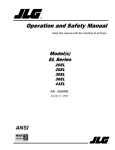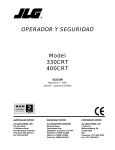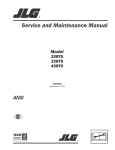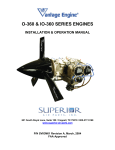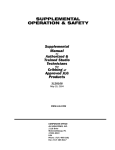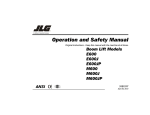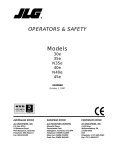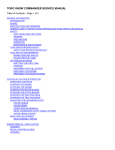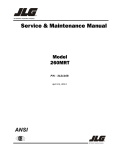Download D:\FMManuals\Sizzors\3120881\Drive Hub.eps
Transcript
Service and Maintenance Manual Model 3369electric 3969electric 3120881 June 13, 2000 INTRODUCTION - MAINTENANCE SAFETY PRECAUTIONS SECTION A. INTRODUCTION - MAINTENANCE SAFETY PRECAUTIONS A.A GENERAL This section contains the general safety precautions which must be observed during maintenance of the aerial platform. It is of utmost importance that maintenance personnel pay strict attention to these warnings and precautions to avoid possible injury to themselves or others, or damage to the equipment. A maintenance program must be followed to ensure that the machine is safe to operate. MODIFICATION OF THE MACHINE WITHOUT CERTIFICATION BY A RESPONSIBLE AUTHORITY THAT THE MACHINE IS AT LEAST AS SAFE AS ORIGINALLY MANUFACTURED, IS A SAFETY VIOLATION. The specific precautions to be observed during maintenance are inserted at the appropriate point in the manual. These precautions are, for the most part, those that apply when servicing hydraulic and larger machine component parts. Your safety, and that of others, is the first consideration when engaging in the maintenance of equipment. Always be conscious of weight. Never attempt to move heavy parts without the aid of a mechanical device. Do not allow heavy objects to rest in an unstable position. When raising a portion of the equipment, ensure that adequate support is provided. Relieve system pressure by cycling the applicable control several times with the engine stopped and ignition on, to direct any line pressure back into the reservoir. Pressure feed lines to system components can then be disconnected with minimal fluid loss. A.C MAINTENANCE FAILURE TO COMPLY WITH SAFETY PRECAUTIONS LISTED IN THIS SECTION MAY RESULT IN MACHINE DAMAGE, PERSONNEL INJURY OR DEATH AND IS A SAFETY VIOLATION. • NO SMOKING IS MANDATORY. NEVER REFUEL DURING ELECTRICAL STORMS. ENSURE THAT FUEL CAP IS CLOSED AND SECURE AT ALL OTHER TIMES. • REMOVE ALL RINGS, WATCHES AND JEWELRY WHEN PERFORMING ANY MAINTENANCE. • DO NOT WEAR LONG HAIR UNRESTRAINED, OR LOOSE-FITTING CLOTHING AND NECKTIES WHICH ARE APT TO BECOME CAUGHT ON OR ENTANGLED IN EQUIPMENT. • OBSERVE AND OBEY ALL WARNINGS AND CAUTIONS ON MACHINE AND IN SERVICE MANUAL. • KEEP OIL, GREASE, WATER, ETC. WIPED FROM STANDING SURFACES AND HAND HOLDS. • USE CAUTION WHEN CHECKING A HOT, PRESSURIZED COOLANT SYSTEM. • NEVER WORK UNDER AN ELEVATED BOOM UNTIL BOOM HAS BEEN SAFELY RESTRAINED FROM ANY MOVEMENT BY BLOCKING OR OVERHEAD SLING, OR BOOM SAFETY PROP HAS BEEN ENGAGED. SINCE THE M ACHINE M ANUFA CTURER HAS NO DIRECT CONTROL OVER THE FIELD INSPECTION AND MAINTENANCE, SAFETY IN THIS AREA RESPONSIBILITY OF THE OWNER/OPERATOR. • BEFORE MAKING ADJUSTMENTS, LUBRICATING OR PERFORMING ANY OTHER MAINTENANCE, SHUT OFF ALL POWER CONTROLS. • BATTERY SHOULD ALWAYS BE DISCONNECTED DURING REPLACEMENT OF ELECTRICAL COMPONENTS. A.B HYDRAULIC SYSTEM SAFETY It should be noted that the machines hydraulic systems operate at extremely high potentially dangerous pressures. Every effort should be made to relieve any system pressure prior to disconnecting or removing any portion of the system. 3120881 • KEEP ALL SUPPORT EQUIPMENT AND ATTACHMENTS STOWED IN THEIR PROPER PLACE. • USE ONLY APPROVED, NONFLAMMABLE CLEANING SOLVENTS. – JLG Sizzor – a INTRODUCTION - MAINTENANCE SAFETY PRECAUTIONS REVISON LOG Original Issue - March 25, 1999 (This manual was part of complete manual 3120835) Revised - March 13, 2000 Page 1-1 Updated June 13, 2000 Page 2-11 Updated June 13, 2000 b – JLG Sizzor – 3120881 TABLE OF CONTENTS TABLE OF CONTENTS SUBJECT - SECTION, PARAGRAPH PAGE NO. SECTION A - INTRODUCTION - MAINTENANCE SAFETY PRECAUTIONS A.A A.B A.C General . . . . . . . . . . . . . . . . . . . . . . . . . . . . . . . . . . . . . . . . . . . . . . . . . . . . . . . . . . . . . . . . . . . . . .a-a Hydraulic System Safety . . . . . . . . . . . . . . . . . . . . . . . . . . . . . . . . . . . . . . . . . . . . . . . . . . . . . . . . .a-a Maintenance . . . . . . . . . . . . . . . . . . . . . . . . . . . . . . . . . . . . . . . . . . . . . . . . . . . . . . . . . . . . . . . . . .a-a SECTION 1 - SPECIFICATIONS 1.1 1.2 1.3 1.4 1.5 1.6 1.7 1.8 1.9 1.10 1.11 Capacities . . . . . . . . . . . . . . . . . . . . . . . . . . . . . . . . . . . . . . . . . . . . . . . . . . . . . . . . . . . . . . . . . . . .1-1 Component Data . . . . . . . . . . . . . . . . . . . . . . . . . . . . . . . . . . . . . . . . . . . . . . . . . . . . . . . . . . . . . . .1-1 Performance Data . . . . . . . . . . . . . . . . . . . . . . . . . . . . . . . . . . . . . . . . . . . . . . . . . . . . . . . . . . . . . .1-1 Torque Specifications . . . . . . . . . . . . . . . . . . . . . . . . . . . . . . . . . . . . . . . . . . . . . . . . . . . . . . . . . . .1-2 Lubrication. . . . . . . . . . . . . . . . . . . . . . . . . . . . . . . . . . . . . . . . . . . . . . . . . . . . . . . . . . . . . . . . . . . .1-2 Pressure Settings . . . . . . . . . . . . . . . . . . . . . . . . . . . . . . . . . . . . . . . . . . . . . . . . . . . . . . . . . . . . . .1-2 Cylinder Specifications . . . . . . . . . . . . . . . . . . . . . . . . . . . . . . . . . . . . . . . . . . . . . . . . . . . . . . . . . .1-4 Major Component Weights . . . . . . . . . . . . . . . . . . . . . . . . . . . . . . . . . . . . . . . . . . . . . . . . . . . . . . .1-4 Critical Stability Weights . . . . . . . . . . . . . . . . . . . . . . . . . . . . . . . . . . . . . . . . . . . . . . . . . . . . . . . . .1-4 Relays/Circuit Breakers . . . . . . . . . . . . . . . . . . . . . . . . . . . . . . . . . . . . . . . . . . . . . . . . . . . . . . . . . .1-4 Serial Number Locations. . . . . . . . . . . . . . . . . . . . . . . . . . . . . . . . . . . . . . . . . . . . . . . . . . . . . . . . .1-4 SECTION 2 - PROCEDURES 2.1 2.2 2.3 2.4 2.5 2.6 2.7 2.8 2.9 2.10 2.11 2.12 2.13 2.14 2.15 2.16 2.17 2.18 2.19 2.20 General . . . . . . . . . . . . . . . . . . . . . . . . . . . . . . . . . . . . . . . . . . . . . . . . . . . . . . . . . . . . . . . . . . . . . .2-1 Servicing and Maintenance Guidelines . . . . . . . . . . . . . . . . . . . . . . . . . . . . . . . . . . . . . . . . . . . . .2-1 Lubrication Information . . . . . . . . . . . . . . . . . . . . . . . . . . . . . . . . . . . . . . . . . . . . . . . . . . . . . . . . . .2-2 Cylinders - Theory of Operation . . . . . . . . . . . . . . . . . . . . . . . . . . . . . . . . . . . . . . . . . . . . . . . . . . .2-3 Valves - Theory of Operation. . . . . . . . . . . . . . . . . . . . . . . . . . . . . . . . . . . . . . . . . . . . . . . . . . . . . .2-3 Component Functional Description . . . . . . . . . . . . . . . . . . . . . . . . . . . . . . . . . . . . . . . . . . . . . . . .2-4 Wear Pads . . . . . . . . . . . . . . . . . . . . . . . . . . . . . . . . . . . . . . . . . . . . . . . . . . . . . . . . . . . . . . . . . . . .2-4 Motor Controller - Modes of Operation . . . . . . . . . . . . . . . . . . . . . . . . . . . . . . . . . . . . . . . . . . . . . .2-4 Features. . . . . . . . . . . . . . . . . . . . . . . . . . . . . . . . . . . . . . . . . . . . . . . . . . . . . . . . . . . . . . . . . . . . . .2-4 Cylinder Checking Procedures . . . . . . . . . . . . . . . . . . . . . . . . . . . . . . . . . . . . . . . . . . . . . . . . . . . .2-5 Lift Cylinder Removal and Installation. . . . . . . . . . . . . . . . . . . . . . . . . . . . . . . . . . . . . . . . . . . . . . .2-6 Lift Cylinder Repair . . . . . . . . . . . . . . . . . . . . . . . . . . . . . . . . . . . . . . . . . . . . . . . . . . . . . . . . . . . . .2-6 Steer Cylinder Disassembly and Assembly . . . . . . . . . . . . . . . . . . . . . . . . . . . . . . . . . . . . . . . . . .2-11 Tilt Switch Indicator Leveling Procedure. . . . . . . . . . . . . . . . . . . . . . . . . . . . . . . . . . . . . . . . . . . . .2-11 Limit Switches . . . . . . . . . . . . . . . . . . . . . . . . . . . . . . . . . . . . . . . . . . . . . . . . . . . . . . . . . . . . . . . . .2-11 Pressure Setting Procedures . . . . . . . . . . . . . . . . . . . . . . . . . . . . . . . . . . . . . . . . . . . . . . . . . . . . .2-12 Drive Torque Hub . . . . . . . . . . . . . . . . . . . . . . . . . . . . . . . . . . . . . . . . . . . . . . . . . . . . . . . . . . . . . .2-12 Drive Brake Assembly . . . . . . . . . . . . . . . . . . . . . . . . . . . . . . . . . . . . . . . . . . . . . . . . . . . . . . . . . . .2-13 Free Wheeling Procedure . . . . . . . . . . . . . . . . . . . . . . . . . . . . . . . . . . . . . . . . . . . . . . . . . . . . . . . .2-16 Preventive Maintenance and Inspection Schedule. . . . . . . . . . . . . . . . . . . . . . . . . . . . . . . . . . . . .2-16 SECTION 3 - TROUBLESHOOTING 3.1 3.2 3.3 3120881 General . . . . . . . . . . . . . . . . . . . . . . . . . . . . . . . . . . . . . . . . . . . . . . . . . . . . . . . . . . . . . . . . . . . . . .3-1 Troubleshooting Information. . . . . . . . . . . . . . . . . . . . . . . . . . . . . . . . . . . . . . . . . . . . . . . . . . . . . .3-1 Hydraulic Circuit Checks. . . . . . . . . . . . . . . . . . . . . . . . . . . . . . . . . . . . . . . . . . . . . . . . . . . . . . . . .3-1 – JLG Sizzor – i TABLE OF CONTENTS (Continued) LIST OF FIGURES FIGURE NO. 1-1. 1-2. 1-3. 2-1. 2-2. 2-3. 2-4. 2-5. 2-6. 2-7. 2-8. 2-9. 2-10. 2-11. 2-12. 2-13. 2-14. 2-15. 3-1. 3-2. 3-3. 3-4. 3-5. 3-6. 3-7. 3-8. 3-9. TITLE PAGE NO. Lubrication Chart. . . . . . . . . . . . . . . . . . . . . . . . . . . . . . . . . . . . . . . . . . . . . . . . . . . . . . . . . . . . . . .1-3 Serial Number Location. . . . . . . . . . . . . . . . . . . . . . . . . . . . . . . . . . . . . . . . . . . . . . . . . . . . . . . . . .1-4 Torque Chart . . . . . . . . . . . . . . . . . . . . . . . . . . . . . . . . . . . . . . . . . . . . . . . . . . . . . . . . . . . . . . . . . .1-5 Barrel Support . . . . . . . . . . . . . . . . . . . . . . . . . . . . . . . . . . . . . . . . . . . . . . . . . . . . . . . . . . . . . . . . .2-6 Capscrew Removal . . . . . . . . . . . . . . . . . . . . . . . . . . . . . . . . . . . . . . . . . . . . . . . . . . . . . . . . . . . . .2-6 Rod Support . . . . . . . . . . . . . . . . . . . . . . . . . . . . . . . . . . . . . . . . . . . . . . . . . . . . . . . . . . . . . . . . . .2-7 Tapered Bushing Removal . . . . . . . . . . . . . . . . . . . . . . . . . . . . . . . . . . . . . . . . . . . . . . . . . . . . . . .2-7 Oil-lite Bearing Installation. . . . . . . . . . . . . . . . . . . . . . . . . . . . . . . . . . . . . . . . . . . . . . . . . . . . . . . .2-8 Rod Seal Installation . . . . . . . . . . . . . . . . . . . . . . . . . . . . . . . . . . . . . . . . . . . . . . . . . . . . . . . . . . . .2-8 Wiper Seal Installation. . . . . . . . . . . . . . . . . . . . . . . . . . . . . . . . . . . . . . . . . . . . . . . . . . . . . . . . . . .2-8 Installation of Head Seal Kit . . . . . . . . . . . . . . . . . . . . . . . . . . . . . . . . . . . . . . . . . . . . . . . . . . . . . .2-8 Tapered Bushing Installation . . . . . . . . . . . . . . . . . . . . . . . . . . . . . . . . . . . . . . . . . . . . . . . . . . . . .2-9 Piston Seal Kit Installation . . . . . . . . . . . . . . . . . . . . . . . . . . . . . . . . . . . . . . . . . . . . . . . . . . . . . . . .2-9 Poly-Pak Piston Seal Installation. . . . . . . . . . . . . . . . . . . . . . . . . . . . . . . . . . . . . . . . . . . . . . . . . . .2-9 Rod Assembly Installation. . . . . . . . . . . . . . . . . . . . . . . . . . . . . . . . . . . . . . . . . . . . . . . . . . . . . . . .2-9 Pressure Setting Procedures . . . . . . . . . . . . . . . . . . . . . . . . . . . . . . . . . . . . . . . . . . . . . . . . . . . . .2-12 Drive Torque Hub Assembly . . . . . . . . . . . . . . . . . . . . . . . . . . . . . . . . . . . . . . . . . . . . . . . . . . . . . .2-14 Drive Brake Assembly . . . . . . . . . . . . . . . . . . . . . . . . . . . . . . . . . . . . . . . . . . . . . . . . . . . . . . . . . . .2-15 Hydraulic Schematic . . . . . . . . . . . . . . . . . . . . . . . . . . . . . . . . . . . . . . . . . . . . . . . . . . . . . . . . . . . .3-11 Platform Wiring On Machines Before Serial Number 020071522 (Sheet 1 of 2) . . . . . . . . . . . . . .3-12 Platform Wiring On Machines Before Serial Number 020071522(Sheet 2 of 2) . . . . . . . . . . . . . .3-13 Ground Control Wiring On Machines Before Serial Number 020071522 (Sheet 1 of 2) . . . . . . . .3-14 Ground Control Wiring On Machines Before Serial Number 020071522 (Sheet 2 of 2) . . . . . . . .3-15 Platform Wiring On Machines After and Including Serial Number 020071522 (Sheet 1 of 2) . . . .3-16 Platform Wiring On Machines After and Including Serial Number 020071522 (Sheet 2 of 2) . . . .3-17 Ground Control Wiring On Machines After and Including Serial Number 020071522 (Sheet 1 of 2)3-18 Ground Control Wiring On Machines After and Including Serial Number 020071522 (Sheet 2 of 2)3-19 LIST OF TABLES TABLE NO. 1-1 1-2 1-3 1-4 1-5 1-6 1-7 2-1 2-2 2-3 2-4 3-1 3-2 3-3 3-4 3-5 3-6 3-7 ii TITLE PAGE NO. Torque Specifications . . . . . . . . . . . . . . . . . . . . . . . . . . . . . . . . . . . . . . . . . . . . . . . . . . . . . . . . . . .1-2 Hydraulic Oil . . . . . . . . . . . . . . . . . . . . . . . . . . . . . . . . . . . . . . . . . . . . . . . . . . . . . . . . . . . . . . . . . .1-2 Lubrication Specifications . . . . . . . . . . . . . . . . . . . . . . . . . . . . . . . . . . . . . . . . . . . . . . . . . . . . . . . .1-2 Lubrication Chart. . . . . . . . . . . . . . . . . . . . . . . . . . . . . . . . . . . . . . . . . . . . . . . . . . . . . . . . . . . . . . .1-3 Cylinder Specifications . . . . . . . . . . . . . . . . . . . . . . . . . . . . . . . . . . . . . . . . . . . . . . . . . . . . . . . . . .1-4 Major Component Weights . . . . . . . . . . . . . . . . . . . . . . . . . . . . . . . . . . . . . . . . . . . . . . . . . . . . . . .1-4 Critical Stability Weights . . . . . . . . . . . . . . . . . . . . . . . . . . . . . . . . . . . . . . . . . . . . . . . . . . . . . . . . .1-4 Flash Codes . . . . . . . . . . . . . . . . . . . . . . . . . . . . . . . . . . . . . . . . . . . . . . . . . . . . . . . . . . . . . . . . . .2-5 Cylinder Piston Nut Torque Specifications . . . . . . . . . . . . . . . . . . . . . . . . . . . . . . . . . . . . . . . . . . .2-10 Holding Valve Torque Specifications . . . . . . . . . . . . . . . . . . . . . . . . . . . . . . . . . . . . . . . . . . . . . . .2-10 Preventive Maintenance and Inspection Schedule . . . . . . . . . . . . . . . . . . . . . . . . . . . . . . . . . . . .2-17 Platform Assembly Troubleshooting. . . . . . . . . . . . . . . . . . . . . . . . . . . . . . . . . . . . . . . . . . . . . . . .3-2 Chassis Troubleshooting . . . . . . . . . . . . . . . . . . . . . . . . . . . . . . . . . . . . . . . . . . . . . . . . . . . . . . . .3-4 Hydraulic System Troubleshooting. . . . . . . . . . . . . . . . . . . . . . . . . . . . . . . . . . . . . . . . . . . . . . . . .3-6 Electrical System Troubleshooting . . . . . . . . . . . . . . . . . . . . . . . . . . . . . . . . . . . . . . . . . . . . . . . . .3-7 Flash Code Troubleshooting Messages . . . . . . . . . . . . . . . . . . . . . . . . . . . . . . . . . . . . . . . . . . . . .3-8 Control Module Settings for Machines After and Including Serial Number 020071522 . . . . . . . .3-9 Control Module Settings for Machines Before Serial Number 020071522 . . . . . . . . . . . . . . . . . .3-9 – JLG Sizzor – 3120881 SECTION 1 - SPECIFICATIONS SECTION 1. SPECIFICATIONS 1.1 CAPACITIES 1.3 PERFORMANCE DATA Hydraulic Oil Tank Travel Speed 41.6 liters (11.0 gallons) 3369/3969 electric - 4.8 kmh (3.0 mph) High Drive for/rev (sec/15.2 m) - 11-13 sec Hydraulic System Creep Drive for/rev (sec/15.2 m) - 50-60 sec Approximately 50.0 liters (13.2 gallons) Gradeability Torque Hubs (2) 25% 0.5 liters (17 ounces) Turning Radius (Inside) 3369 electric - 1.52 m (60 in) 1.2 COMPONENT DATA 3969 electric - 1.52 m (60 in) Battery Charger Turning Radius (Outside) Input, 110 VAC,60 HZ 3369 electric - 3.81 m (149 in) Output, 48 VDC (23 Amp) 3969 electric - 3.81 m (149 in) Batteries (8) Platform Lift Speed 3369 electric - Lift Up - 75 - 80 seconds Standard - 6 Volt, 225 AmpHour 3369 electric - Lift Down - 50 - 60 seconds High Output - 6 Volt 370 AmpHour 3969 electric - Lift Up - 75 - 80 seconds Drive System 3969 electric - Lift Down - 50 - 60 seconds Drive Motor - 36 VDC, 4.1 H.P. @ 1880 rpm. continuous, rotation - reversible Platform Capacity Drive Brake- 24 VDC, spring-applied, electrically released 3369 electric - 455 kg (1000 lbs) 3969 electric - 340 kg (750 lbs) Steer System Tires - ST205 75R15, Load Range C, 6 Ply Rating, Poly Filled Platform Extension Capacity 3369 electric - 230 kg (500 lbs) 3969 electric - 230 kg (500 lbs) Toe-In - Adjust to 6.4 mm (1/4 in) overall Machine Weight Hydraulic Filter 3369 electric - 3629 kg (8,000 lbs) Return, 25 Micron 3969 electric - 3992 kg (8,800 lbs) Hydraulic Pump/Electric Motor Assembly Machine Height (w/Rails Folded Down) Motor - 48 VDC, 5.5 H.P. @ 2500 rpm 3369 electric - 1.85 m (73 in) Pump - 1.6 cm[3]/rev (.0.098 in.[3]/rev) 3969 electric - 2.01 m (79 in) Pump Output - 4.13 lpm (1.09 gpm) @ 137.9 Bar (2000 psi) Machine Length (Stowed) 3369 electric - 2.77 m (109 in) 3969 electric - 2.77 m (109 in) Updated 6/13/00 3120881 – JLG Sizzor – 1-1 SECTION 1 - SPECIFICATIONS NOTE: Hydraulic oils must have anti-wear qualities at least to API Service Classification GL-3, and sufficient chemical stability for mobile hydraulic system service. JLG Industries recommends Mobilfluid 424 hydraulic oil, which has an SAE viscosity of 10W-20 and a viscosity index of 152 . When temperatures remain consistently below -7 ° C (2° F ), JLG recommends the use of Mobil DTE 11. Machine Width 3369 electric - 1.80 m (69 in) 3969 electric - 1.80 m (69 in) Wheelbase 3369 electric - 1.98 m (77 in) 3969 electric - 1.98 m (77 in) NOTE: Aside from JLG recommendations, it is not advisable to mix oils of different brands or types, as they may not contain the same required additives or be of comparable viscosities. If use of hydraulic oil other than Mobilfluid 424 is desired, contact JLG Industries for proper recommendations. Ground Clearance 3369 electric - 17.8 cm (7 in) 3969 electric - 17.8 cm (7 in) Maximum Tire Load Lubrication Specifications 3369 electric - 1388 kg (3060 lb) 3969 electric - 1427 kg (3145 lb) Table 1-3. Lubrication Specifications Maximum Bearing Pressure KEY SPECIFICATIONS 3369 electric - 3.9 bar (56 psi) EPGL Extreme Pressure Gear Lube (oil) meeting API service classification GL-5 or MIL-Spec MIL-L-2105 3969 electric - 3.9 bar (58 psi) HO Hydraulic Oil. API service classification Gl-3, e.g. Mobil 424 or BP Energol SHS46. LL Synthetic Lithium Lubricant, Gredag 741 Grease. 1.4 TORQUE SPECIFICATIONS *MPG may be substituted for these lubricants, if necessary, but service intervals will be reduced. Table 1-1. Torque Specifications DESCRIPTION TORQUE VALUE (DRY) INTERVAL HOURS Torque Hub 75 ft. lbs. 102 (NM) 500 Wheel Bolts 90 ft. lbs. (122 NM) 50 NOTE: Refer to Lubrication Chart for specific lubrication procedures. 1.6 PRESSURE SETTINGS Lift Up Relief - 3369ES - 172 bar (2500 psi) NOTE: When maintenance becomes necessary or a fastener has loosened, refer to the Torque Chart to determine proper torque value. 3969ES -186 bar (2700 psi) Lift Down Relief - 69 bar (1000 psi) Steer Relief - 82.7 bar (1200 psi ) 1.5 LUBRICATION NOTE: Main Relief at Pump - 186.2 bar (2700 psi) Table 1-2. Hydraulic Oil Hydraulic System Operating Temperature Range SAE Viscosity Grade 0° F to 23° F (-18°C to -5°C) 10W 0° F to 210° F (-18°C to +99°C) 10W-20, 10W- 0 50° F to 210° F (+10°C to +99°C) 20W-20 Updated 11/16/99 1-2 – JLG Sizzor – 3120881 SECTION 1 - SPECIFICATIONS Figure 1-1. Lubrication Chart Table 1-4. Lubrication Chart INDEX NUMBER COMPONENT NO/TYPE LUBE POINTS LUBE/METHOD INTERVAL HOURS 1 Hydraulic Oil Fill Cap/Drain Plug HO-Mobil 424 8/800 Check oil every 8 hours of operation. Change oil every 800 hours of operation. 2 Torque Hub Fill Plug/Half Full EPGL-SAE 90 2000 Check oil level at side plug on hub. 3 Wheel Bearings N/A MPG - Repack 800 2 years 4 Sliding Pads Wear Pads (8) MPG - Brush 50 N/A 5 (not shown) Hydraulic Filter Element N/A Replaceable Element 40/250 Replace filter element after first 40 hours of operation then every 250 hours thereafter. KEY TO LUBRICANTS: HO - Hydraulic Oil -Mobil 424 EPGL - Extreme Pressure Gear Lube 3120881 COMMENTS NOTE: Be sure to lubricate like items on each side of the machine. Recommended lubricating intervals are based on machine operations under normal conditions. For machines used in multi-shift operations and/or exposed to hostile environments or conditions, lubricating frequencies must be increased accordingly. – JLG Sizzor – 1-3 SECTION 1 - SPECIFICATIONS 1.7 CYLINDER SPECIFICATIONS 1.9 CRITICAL STABILITY WEIGHTS . Table 1-7. Critical Stability Weights Table 1-5. Cylinder Specifications DESCRIPTION BORE STROKE ROD DIA. Lift Cylinder 10.16 cm 37.29 cm 6.35 cm Steer Cylinder (Double Rod) 5.08 cm 7.62 cm each direction 3.18 cm each rod 1.8 COMPONENT LBS. KG. Platform 761 345 Platform Extension 320 145 Foam Filled Tires 150 68 Battery (Each) 77 35 MAJOR COMPONENT WEIGHTS Table 1-6. Major Component Weights COMPONENT 3369 ELECTRIC 3369/3969 ELECTRIC 3969 ELECTRIC 1.10 RELAYS/CIRCUIT BREAKERS LBS. KG. LBS. KG. Platform 761 345 761 345 Platform Extension 320 145 320 145 Console Box Arm Assembly (Includes Lift Cylinders) 3393 1539 3903 1770 Relay - Potter & Brumfield P/N K10P-11D15-48 48VDC. Chassis (Includes Battery Box and Foam filled Tires) 3662 1661 3662 1661 Machine Complete (GVW) 8000 3629 8800 3992 Circuit Breaker - Wood Electric Corp. P/N W58 x BIA4 A-5. 1.11 SERIAL NUMBER LOCATIONS For machine identification, a serial number plate is affixed to the front of the frame. If the serial number plate is damaged or missing, the machine serial number is stamped on the right front of the machine frame. Figure 1-2. Serial Number Location 1-4 – JLG Sizzor – 3120881 Figure 1-3. Torque Chart SECTION 1 - SPECIFICATIONS 3120881 – JLG Sizzor – 1-5 SECTION 1 - SPECIFICATIONS This page intentionally left blank. 1-6 – JLG Sizzor – 3120881 SECTION 2 - PROCEDURES SECTION 2. PROCEDURES 2.1 GENERAL 1. This section provides information necessary to perform maintenance on the sizzor lift. Descriptions, techniques and specific procedures are designed to provide the safest and most efficient maintenance for use by personnel responsible for ensuring the correct installation and operation of machine components and systems. WHEN AN ABNORMAL CONDITION IS NOTED AND PROCEDURES CONTAINED HEREIN DO NOT SPECIFICALLY RELATE TO THE NOTED IRREGULARITY, WORK SHOULD BE STOPPED AND TECHNICALLY QUALIFIED GUIDANCE OBTAINED BEFORE WORK IS RESUMED. 2. The maintenance procedures included consist of servicing and component removal and installation, disassembly, and assembly, inspection, lubrication and cleaning. Information on any special tools or test equipment is also provided where applicable. 2.2 SERVICING AND MAINTENANCE GUIDELINES 3. Clean and inspect all parts during servicing or maintenance, and assure that all passages and openings are unobstructed. Cover all parts to keep them clean. Be sure all parts are clean before they are installed. New parts should remain in their containers until they are ready to be used. Component Removal and Installation 1. Use adjustable lifting devices, whenever possible, if mechanical assistance is required. All slings (chains, cables, etc.) should be parallel to each other and as near perpendicular as possible to top of part being lifted. 2. Should it be necessary to remove a component on an angle, keep in mind that the capacity of an eyebolt or similar bracket lessens, as the angle between the supporting structure and the component becomes less than 90 degrees. 3. If a part resists removal, check to see whether all nuts, bolts, cables, brackets, wiring, etc. have been removed and that no adjacent parts are interfering. General The following information is provided to assist you in the use and application of servicing and maintenance procedures contained in this chapter. Safety and Workmanship Your safety and that of others is the first consideration when engaging in the maintenance of equipment. Always be conscious of weight. Never attempt to move heavy parts without the aid of a mechanical device. Do not allow heavy objects to rest in an unstable position. When raising a portion of the equipment, ensure that adequate support is provided. Cleanliness Component Disassembly and Reassembly When disassembling or reassembling a component, complete the procedural steps in sequence. Do not partially disassemble or assemble one part, then start on another. Always recheck your work to assure that nothing has been overlooked. Do not make any adjustments, other than those recommended, without obtaining proper approval. Pressure Fit Parts When assembling pressure fit parts, use an “anti-seize” or molybdenum disulfide base compound to lubricate the mating surface. Bearings 1. The most important single item in preserving the long service life of a machine is to keep dirt and foreign materials out of the vital components. Precautions have been taken to safeguard against this. Shields, covers, seals and filters are provided to keep oil supplies clean; however, these items must be maintained on a scheduled basis in order to function properly. 3120881 2. At any time when hydraulic oil lines are disconnected, clear adjacent areas as well as the openings and fittings themselves. As soon as a line or component is disconnected, cap or cover all openings to prevent entry of foreign matter. 1. When a bearing is removed, cover it to keep out dirt and abrasives. Clean bearings in nonflammable cleaning solvent and allow to drip dry. Compressed air can be used but do not spin the bearing. 2. Discard bearings if the races and balls (or rollers) are pitted, scored or burned. – JLG Sizzor – 2-1 SECTION 2 - PROCEDURES 3. If bearing is found to be serviceable, apply a light coat of oil and wrap it in clean (waxed) paper. Do not unwrap reusable or new bearings until they are ready to be installed. 4. Lubricate new or used serviceable bearings before installation. When pressing a bearing into a retainer or bore, apply pressure to the outer race. If the bearing is to be installed on a shaft, apply pressure to the inner race. Batteries Clean batteries using a non-metallic brush and a solution of baking soda and water. Rinse with clean water. After cleaning, thoroughly dry batteries and coat terminals with an anti-corrosion compound. Lubrication and Servicing Components and assemblies requiring lubrication and servicing are shown in Section 1. Gaskets Check that holes in gaskets align with openings in the mating parts. If it becomes necessary to hand fabricate a gasket, use gasket material or stock of equivalent material and thickness. Be sure to cut holes in the right location as blank gaskets can cause serious system damage. Bolt Usage and Torque Application 1. Use bolts of proper length. A bolt which is too long will bottom before the head is tight against its related part. If a bolt is too short, there will not be enough thread area to engage and hold the part properly. When replacing bolts, use only those having the same specifications of the original, or one which is equivalent. 2.3 LUBRICATION INFORMATION Hydraulic System 1. The primary enemy of a hydraulic system is contamination. Contaminants enter the system by various means, e.g.; inadequate hydraulic oil, allowing moisture, grease, filings, sealing components, sand, etc. to enter when performing maintenance, or by permitting the pump to cavitate due to insufficient system warm-up. Hydraulic Lines and Electrical Wiring 2. The design and manufacturing tolerances of the component working parts are very close, therefore, even the smallest amount of dirt or foreign matter entering a system can cause wear or damage to the components and generally results in faulty operation. Every precaution must be taken to keep hydraulic oil clean, including reserve oil in storage. Hydraulic system filters should be checked, cleaned, and/or replaced at the specified intervals required in Section 1. Always examine filters for evidence of metal particles. Clearly mark or tag hydraulic lines and electrical wiring, as well as their receptacles, when disconnecting or removing them from the unit. This will assure that they are correctly reinstalled. 3. Cloudy oils indicate a high moisture content which permits organic growth, resulting in oxidation or corrosion. If this condition occurs, the system must be drained, flushed, and refilled with clean oil. 2. Unless specific torque requirements are given within the text, standard torque values should be used on heat treated bolts, studs and steel nuts, in accordance with recommended shop practices. Hydraulic System 1. Keep the system clean. If evidence of metal or rubber particles are found in the hydraulic system, drain and flush the entire system. 2. Disassemble and reassemble parts on clean work surface. Clean all metal parts with non-flammable cleaning solvent. Lubricate components, as required, to aid assembly. 4. It is not advisable to mix oils of different brands or types, as they may not contain the same required additives or be of comparable viscosities. Good grade mineral oils, with viscosities suited to the ambient temperatures in which the machine is operating, are recommended for use. NOTE: Metal particles may appear in the oil or filters of new machines due to the wear-in of meshing components. Hydraulic Oil Lubrication Service applicable components with the amount, type, and grade of lubricant recommended in this manual, at the specified interval. When recommended lubricants are not available, consult your local supplier for an equivalent that meets or exceeds the specifications listed. 2-2 1. Refer to Lubrication Specification Table for recommendations for viscosity ranges. 2. JLG recommends Mobil Fluid 424 Hydraulic Oil, which has an SAE viscosity of 10W-20 and a viscosity index of 152. – JLG Sizzor– 3120881 SECTION 2 - PROCEDURES NOTE: Start-up of hydraulic system with oil temperatures below -26° C is not recommended. If it is necessary to start the system in a sub-zero environment, it will be necessary to heat the oil with a low density 100VAC heater to a minimum temperature of -26° C. 3. The only exception to the above is to drain and fill the system with Mobil DTE13 oil or its equivalent. This will allow start up at temperatures down to -29° C. However, use of this oil will give poor performance at temperatures above 49° C. Systems using DTE13 oil should not be operated at temperatures above 94° C under any condition. Changing Hydraulic Oil 1. Use of any of the recommended hydraulic oils eliminates the need for changing the oil on a regular basis. However, filter elements must be changed after the first 40 hours of operation and every 250 hours thereafter. If it is necessary to change the oil, use only those oils meeting or exceeding the specifications appearing in this manual. If unable to obtain the same type of oil supplied with the machine, consult local supplier for assistance in selecting the proper equivalent. Avoid mixing petroleum and synthetic base oils. JLG Industries recommends changing the hydraulic oil annually. 2. Use every precaution to keep the hydraulic oil clean. If the oil must be poured from the original container into another, be sure to clean all possible contaminants from the service container. Always clean the mesh element of the filter and replace the cartridge any time the system oil is changed. 3. While the unit is shut down, a good preventive maintenance measure is to make a thorough inspection of all hydraulic components, lines, fittings, etc., as well as a functional check of each system, before placing the machine back in service. Lubrication Specifications Specified lubricants, as recommended by the component manufacturers, are always the best choice, however, multi-purpose greases usually have the qualities which meet a variety of single purpose requirements. Should any question arise regarding the use of greases in maintenance stock, consult your local supplier for evaluation. Refer to Section 1 for an explanation of the lubricant key designations appearing in the Lubrication Chart. 3120881 2.4 CYLINDERS - THEORY OF OPERATION 1. Cylinders are of the double acting type. The Lift and Steer systems incorporate double acting cylinders. A double acting cylinder is one that requires oil flow to operate the cylinder rod in both directions. Directing oil, by actuating the corresponding control valve to the piston side of the cylinder, forces the piston to travel toward the rod end of the barrel, extending the cylinder rod piston attached to rod. When the oil flow is stopped, movement of the rod will stop. By directing oil to the rod side of the cylinder, the piston will be forced in the opposite direction and the cylinder rod will retract. 2. Holding valves are used in the lift circuits to prevent retraction of the cylinder rod should a hydraulic line rupture or leak develop between the cylinder and its related control valve. 2.5 VALVES - THEORY OF OPERATION Control Valves It consists of cartridge type valves in an anodized aluminum manifold. The cartridge valves provide for control of flow, volume of flow and pressure in the hydraulic system. The directional control valves are solenoid operated, three position, 4-way sliding spool type valves. One valve is provided for each of the two functions. Energizing one of the electrical coils on a valve will divert the supply of hydraulic oil to provide motion of that function in one direction. Energizing the other coil will divert the oil for motion in the other direction. When neither coil is energized, the supply of hydraulic oil is blocked. Flow control valves in the lift circuits provide for control of the rate of flow when the oil is flowing out of the cap ends of the cylinders (the load is being lowered). An adjusting screw on each cartridge flow control valve allows the rate of flow (speed) to be adjusted. When oil is flowing into the cap end of the lift cylinders, an internal check valve feature allows unrestricted flow. Pressure relief valves limit the pressure in the steer circuit and the rod end of each lift cylinder. When the pressure in one of those circuits reaches the set point of the valve, the valve opens, allowing enough flow to return to the reservoir so that the set pressure is not exceeded. An adjusting screw on each cartridge relief valve allows the set pressure to be adjusted. The aluminum manifold provides the passages through which the hydraulic oil is diverted to provide the desired movement of the actuators. No moving parts of the valves slide against the manifold and so it is not subject to wear. – JLG Sizzor – 2-3 SECTION 2 - PROCEDURES 2.6 Pump Motor Drive COMPONENT FUNCTIONAL DESCRIPTION Pump motor drive will start only if the following conditions are satisfied: Hydraulic Pump 1. FWD and REV switch off. The single stage gear pump is attached to the electric motor located on the right rear of frame. 2. Traction mode off (brake applied). 3. TEB operate. Manual Descent Pump The manual operated hand pump is located on the right rear of frame behind ground control station. The function is selected in a 3-second window after the TEB has been momentarily CLOSED. The function is selected in a 10-second window after the TEB has been permanently CLOSED. 2.7 WEAR PADS The original thickness of the sliding wear pads is 12.7 mm (5 in). Replace sliding pads when worn to 11.9 mm (4.7 in). 2.8 MOTOR CONTROLLER - MODES OF OPERATION Traction Motor Drive Drive in either forward or reverse will start only if the following conditions are satisfied: Another function was operated less than 3-seconds before. Pump drive shall only be enabled when the direction selector inputs are in neutral and the machine is stationary. Once pump drive mode has been entered, then the status of the direction selector inputs shall no longer interlock pump operation. If a direction switch is selected during pump drive, a procedure fault will occur when the function switch is no longer selected, remaining until both directions and the function switch are no longer selected. 2.9 FEATURES 1. Function switches off. Features in Traction Mode 2. No procedure or diagnostic faults present. Maximum Speed Control 3. TEB operate. The function is selected in a 3-second window after the TEB has been momentary closed. The function is selected in a 10-second window after the TEB has been permanently closed. Another function was operated less than 3-seconds before. 4. FWD or REV selected as appropriate. Once in “drive” mode, activating a function switch shall not cause drive mode to be exited, the pump/traction contactor drive shall not be energized it will be left at the traction position. If a function switch is selected during traction, a procedure fault will occur when neutral is selected, remaining until a function switch and both directions are no longer selected. When neutral is selected, the controller will control smooth stopping of the machine, using plug braking, before the electric brake is allowed to operate. The controller incorporates a function to limit the maximum speed of the machine to a percentage of maximum possible speed. The function operates in such a manner as to control vehicle speed by limiting the percentage on of the switching device to keep the machine speed below the maximum permitted value or, if required, to apply variable plug braking to restrict machine speed when traveling down a grade. The speed is controlled based on the percentage of accelerator input. Features in Pump Mode 1. Proportional Control of Pump Motor Speed - The pump motor speed shall be controlled by varying the percentage on of the switching element in relation to a separate pump accelerator input. 2. Soft Start - The pump motor speed control incorporates a “soft start” facility by applying acceleration delay to changes in the applied percentage on of the switching element. If a function switch is activated in neutral, when the vehicle has stopped and the brake is applied, then pump mode will become operational. 2-4 – JLG Sizzor– 3120881 SECTION 2 - PROCEDURES General Features 3. Activate hydraulic system, and activate cylinder extend function. Diagnostics To obtain flash code, depress enable switch and repeat operation which caused fault. After fault occurs, maintain function position and read flash code. NOTE: Flash code repeats after pause. Flash code readings must be taken from platform control box with unit switched to platform. Table 2-1. Flash Codes Code Description LED On Controller Operational LED Off Internal fault or power not turned on 1 Flash Internal fault 2 Flashes Procedure fault 3 Flashes Motor permanently low 4 Flashes Motor permanently high 5 Flashes Motor neither low nor high (Open circuit) 6 Flashes Faulty drive hand controller 7 Flashes Low battery voltage 8 Flashes Thermal cutback, controller 10 Flashes Tachometer fault 11 Flashes Tachometer out of calibration 5. With cylinder fully retracted, shut down motor and carefully disconnect hydraulic hose from cylinder extend port. 6. Activate hydraulic system and activate cylinder retract function. Check extend port for leakage. 7. If extend port leakage is less than 6-8 drops per minute, carefully reconnect hose to extend port, then activate cylinder through one complete cycle and check for leaks. If leakage continues at a rate of 6-8 drops per minute or more, cylinder repairs must be made. Cylinders With Single Counterbalance Valve (Lift Cylinder) OPERATE ALL FUNCTIONS FROM GROUND CONTROL STATION ONLY. 1. Using all applicable safety precautions, activate hydraulic system. 2. Raise platform completely and place a suitable overhead lifting device approximately 2.5 cm (1 in) below the platform. NOTE: Refer to Troubleshooting Section 3 for specific flash code troubleshooting information. 2.10 CYLINDER CHECKING PROCEDURES NOTE: Cylinder checks must be performed any time a cylinder component is replaced or when improper system operation is suspected. Cylinder Without Counterbalance Valves (Steer) 1. Using all applicable safety precautions, activate hydraulic system and fully extend cylinder to be checked. Shut down hydraulic system. 2. Carefully disconnect hydraulic hose from retract port of cylinder. There will be initial weeping of hydraulic fluid which can be caught in a suitable container. After initial discharge, there should be no further leakage from the retract port. 3120881 4. If cylinder retract port leakage is less than 6-8 drops per minute, carefully reconnect hose to retract port and retract cylinder. If leakage continues at a rate of 6-8 drops per minute or more, cylinder repairs must be made. 3. After completing the above, shut down hydraulic system and allow machine to sit for 10-15 minutes. This is done to relieve pressure in the hydraulic lines. Carefully remove hydraulic hoses from appropriate cylinder port block. 4. There will be initial weeping of hydraulic fluid, which can be caught in a suitable container. After the initial discharge, there should not be any further leakage from the ports. If leakage continues at a rate of 6-8 drops per minute or more, the following cylinder repairs must be made. If the retract port is leaking, the piston is leaking, the piston seals are defective and must be replaced. If the extend port is leaking, the counterbalance is defective and must be replaced. 5. If no repairs are necessary or when repairs have been made, carefully reconnect hydraulic hoses to the appropriate ports. 6. Remove lifting device from platform, activate hydraulic system and run cylinder through complete cycle to check for leaks and operation. – JLG Sizzor – 2-5 SECTION 2 - PROCEDURES 2.11 LIFT CYLINDER REMOVAL AND INSTALLATION 2.12 LIFT CYLINDER REPAIR NOTE: The following are general procedures that apply to all of the cylinders on this machine. Procedures that apply to a specific cylinder will be so noted. Lift Cylinder Removal 1. Place the machine on a flat and level surface. Start the motor and raise the platform. Shut down the motor and attach a suitable lifting device to the platform. 2. Remove the bolt, locknut and keeper shaft securing the cylinder rod attach pin to the upper inner arm assembly. Using a suitable brass drift, drive out the rod end attach pin from the arm assembly. 3. Retract the cylinder rod completely. 4. Tag and disconnect, then cap the lift cylinder hydraulic lines and ports. 5. Remove the bolt, locknut and keeper shaft securing the cylinder rod attach pin to the upper inner arm assembly. Using a suitable brass drift, drive out the rod end attach pin from the arm assembly. Disassembly DISASSEMBLY OF THE CYLINDER SHOULD BE PERFORMED ON A CLEAN WORK SURFACE IN A DIRT FREE WORK AREA. 1. Operate the hydraulic power source and extend the cylinder. Shut down and disconnect the power source. Adequately support the cylinder rod, if necessary. 2. If applicable, remove the cartridge-type holding valve and fittings from the cylinder port block. Discard o-rings. 6. Carefully remove the cylinder from the sizzor lift and place in a suitable work area. Lift Cylinder Installation 1. Install lift cylinder in place using a suitable slings, aligning barrel end attaching pin mounting holes on lower arm assembly. 2. Using a suitable drift, drive the barrel end attach pin through the mounting holes in the lift cylinder and the lower arm assembly. Secure in place with bolt, locknut and keeper shaft. Figure 2-1. Barrel Support 3. Place the cylinder barrel into a suitable holding fixture. 3. Remove cylinder port plugs and hydraulic line caps and correctly attach lines to cylinder ports. 4. Extend the cylinder rod until the attach pin hole aligns with those in the upper arm assembly. Using a suitable drift, drive the cylinder rod attach pin through the aligned holes, taking care to align the pin retaining holes with the hole on the arm assembly. Secure the pin in place with bolt, locknut and keeper shaft. 5. Lower platform to stowed position and shut down motor. Check hydraulic fluid level and adjust accordingly. Figure 2-2. Capscrew Removal 2-6 – JLG Sizzor– 3120881 SECTION 2 - PROCEDURES 4. To aid in realignment, mark cylinder head and barrel with a center punch. 5. Using a suitable spanner wrench, loosen the spanner nut retainer and remove the spanner nut from the cylinder barrel. 6. Attach a suitable pulling device to the cylinder rod port block or cylinder rod end, as applicable. EXTREME CARE SHOULD BE TAKEN WHEN REMOVING THE CYLINDER ROD, HEAD, AND PISTON. AVOID PULLING THE ROD OFFCENTER, WHICH COULD CAUSE DAMAGE TO THE PISTON AND CYLINDER BARREL SURFACES. Figure 2-4. Tapered Bushing Removal 16. Remove the rod from the holding fixture. Remove the cylinder head and retainer plate from the rod. Cleaning and Inspection 1. Clean all parts thoroughly in an approved cleaning solvent. 2. Inspect the cylinder rod for scoring, tapering, ovality, or other damage. If necessary, dress rod with Scotch Brite or equivalent. Replace rod if necessary. 3. Inspect threaded portion of rod for damage. Dress threads as necessary. Figure 2-3. Rod Support 8. With the barrel clamped securely, apply pressure to the rod pulling device and carefully withdraw the complete rod assembly from the cylinder barrel. 9. Using suitable protection, clamp the cylinder rod in a vise or similar holding fixture as close to the piston as possible. 10. If applicable, loosen and remove the nut which attaches the piston to the rod, then remove the piston from the rod. 11. If applicable, loosen and remove the cap screw(s) securing the tapered bushing to the piston. 12. Insert the capscrew(s) in the threaded holes in the outer piece of the tapered bushing. Progressively tighten the cap screw(s) until the bushing is loose on the piston, then remove the bushing from the piston. 13. Screw the piston counter-clockwise, by hand, and remove the piston from the cylinder rod. 14. Remove and discard the piston o-rings, back-up rings, guidelock rings and hydrolock seals. 15. If applicable, remove the piston spacer from the rod. 3120881 4. Inspect inner surface of cylinder barrel tube for scoring or other damage. Check inside diameter for tapering or ovality. Replace if necessary. 5. Inspect threaded portion of barrel for damage. Dress threads as necessary. 6. Inspect piston surface for damage and scoring and for distortion. Dress piston surface or replace piston as necessary. 7. Inspect threaded portion of piston for damage. dress threads as necessary. 8. Inspect seal and o-ring grooves in piston for burrs and sharp edges. Dress applicable surfaces as necessary. 9. Inspect cylinder head inside diameter for scoring or other damage and for ovality and tapering. Replace as necessary. 10. Inspect threaded portion of head for damage. Dress threads as necessary. 11. Inspect seal and o-ring grooves in head for burrs and sharp edges. Dress applicable surfaces as necessary. – JLG Sizzor – 2-7 SECTION 2 - PROCEDURES 12. Inspect cylinder head outside diameter for scoring or other damage and ovality and tapering. Replace as necessary. der head gland groove. Refer to the following illustration for the proper tool size. 13. If applicable, inspect rod and barrel bearings for signs of correct lubrication and excessive wear. If necessary, replace bearings as follows: a. Thoroughly clean steel bushing hole of burrs, dirt, etc. to facilitate bearing installation. b. Inspect steel bushing for wear or other damage. If steel bushing is worn or damaged, rod or barrel (as applicable) must be replaced. c. Lubricate inside of steel bushing with WD-40 prior to bearing installation. Figure 2-6. Rod Seal Installation d. Using arbor of the correct size, carefully press the bearing into the steel bushing. NOTE: Install the cylinder pin into the OIl-lite bearing dry. Lubrication is not required with chrome pins and bearings. IMPROPER SEAL INSTALLATION COULD RESULT IN CYLINDER LEAKAGE AND IMPROPER CYLINDER OPERATION. 2. Using a soft mallet, tap a new wiper seal into the applicable cylinder head gland groove. Install a new wear ring into the applicable head gland groove. Figure 2-5. Oil-lite Bearing Installation 14. Inspect travel limiting collar or spacer for burrs and sharp edges. If necessary, dress inside diameter surface with Scotch Brite or equivalent. 15. If applicable, inspect port block fittings and holding valve. Replace as necessary. Figure 2-7. Wiper Seal Installation 3. Place a new o-ring and back-up seal in the applicable outside diameter groove of the cylinder head. 16. Inspect the oil ports for blockage or the presence of dirt or other foreign material. Repair as necessary. 17. If applicable, inspect piston rings for cracks or other damage. Replace as necessary. Assembly NOTE: Prior to cylinder assembly, ensure that the proper cylinder seal kit is used. NOTE: Apply a light film of hydraulic oil to all components prior to assembly. 1. Using a special tool, pictured in the following illustration, install a new rod seal into the applicable cylin- 2-8 Figure 2-8. Installation of Head Seal Kit 4. Install a washer ring onto the rod, then carefully install the head gland on the rod, ensuring that the – JLG Sizzor– 3120881 SECTION 2 - PROCEDURES wiper and rod seals are not damaged or dislodged. Push the head along the rod to the rod end, as applicable. 5. Carefully slide the piston spacer onto the rod. 6. If applicable, correctly place a new o-ring and backup rings in the inner piston diameter groove. 7. Using suitable protection, clamp the cylinder rod in a vise or similar holding fixture as close to the piston as possible. 8. Carefully thread the piston on the cylinder rod hand tight, ensuring that the o-ring and back-up rings are not damaged or dislodged. 9. Thread the piston onto the rod until it abuts the spacer end and install the tapered bushing. NOTE: When installing the tapered bushing, the piston and mating end of the rod must be free of oil. Figure 2-10. Piston Seal Kit Installation 12. Place new guidelock and hydrolock seals in the applicable outside diameter grooves of both the piston and the cylinder head. Figure 2-11. Poly-Pak Piston Seal Installation 13. Position the cylinder barrel in a suitable holding fixture. Figure 2-9. Tapered Bushing Installation WHEN REBUILDING THE LIFT CYLINDER, APPLY LOCTITE #242 TO TA P E R E D B U S H I N G B O LT S , T H E N T I G H T E N B O LT S SECURELY. REFER TO TABLE 2-2, CYLINDER PISTON NUT TORQUE SPECIFICATIONS AND TABLE 2-3, HOLDING VALVE TORQUE SPECIFICATIONS FOR PROPER BOLT TORQUE VALUES. EXTREME CARE SHOULD BE TAKEN WHEN INSTALLING THE CYLINDER ROD, HEAD, AND PISTON. AVOID PULLING THE ROD OFF-CENTER, WHICH COULD CAUSE DAMAGE TO THE PISTON AND CYLINDER BARREL SURFACES. 10. Install the bolts into the bushing using Loctite #242. Refer to Cylinder Component Torque Specifications Table for proper bolt torque values. 11. Remove the cylinder rod from the holding fixture. WHEN INSTALLING NEW “POLY-PAK” TYPE PISTON SEALS, ENSURE SEALS ARE INSTALLED PROPERLY. (SEE FIGURE 211.) FOR CORRECT SEAL ORIENTATION. IMPROPER SEAL INSTALLATION COULD RESULT IN CYLINDER LEAKAGE AND IMPROPER CYLINDER OPERATION. 3120881 – JLG Sizzor – Figure 2-12. Rod Assembly Installation 2-9 SECTION 2 - PROCEDURES 14. With the barrel clamped securely, and while adequately supporting the rod, insert the piston end into the cylinder barrel. Ensure that the piston loading oring and seal ring are not damaged or dislodged. 15. Continue pushing the rod into the barrel until the cylinder head gland can be inserted into the cylinder barrel. 16. Secure the cylinder head gland using the washer ring and socket head bolts. 17. After the cylinder has been reassembled, the rod should be pushed all the way in (fully retracted) prior to the reinstallation of any holding valve or valves. NOTE: These cylinders use setscrews which should be discarded and replaced whenever they are removed. 19. Remove cylinder rod from the holding fixture. 20. Place new o-rings and seals in the applicable outside diameter grooves of both the piston and the cylinder head. 21. Position the cylinder barrel in a suitable holding fixture. 18. If applicable, install the cartridge-type holding valve and fittings in the port block using new o-rings as applicable. EXTREME CARE SHOULD BE TAKEN WHEN INSTALLING THE CYLINDER ROD, HEAD AND PISTON. AVOID PULLING THE ROD OFF-CENTER, WHICH COULD CAUSE DAMAGE TO THE PISTON AND CYLINDER BARREL SURFACES. WHEN REBUILDING THE LIFT CYLINDERS, APPLY LOCTITE 242 TO PISTON NUT AND SETSCREWS. 22. With barrel clamped securely, and while adequately supporting the rod, insert the piston end into the cylinder barrel. Ensure that the piston loading o-ring and seal ring are not damaged or dislodged. Table 2-2. Cylinder Piston Nut Torque Specifications Description Nut Torque Value (Wet) Setscrew Torque Value (Dry) 400 ft. lbs. (542 NM) 100 in. lbs. (12 NM) N/A N/A Lift Cylinder Steer Cylinder 23. Continue pushing the rod into the barrel until the cylinder head gland can be inserted into the barrel cylinder or if applicable until the cylinder head threads engage the barrel threads. 24. If applicable, apply loctite #222 and secure the cylinder head retainer using a suitable chain wrench. NOTE: Step (25) applies to the Steer Cylinder. 25. Insert the other cylinder head gland into the barrel cylinder. Secure the cylinder head retainer using a suitable chain wrench. Table 2-3. Holding Valve Torque Specifications 2-10 Description Torque Value Sun - 7/8 hex M20 x1.5 thds 30-35 ft lb (41-48 Nm) Sun - 1-1/8 hex 1 - 14 UNS thds 45-50 ft lb (61-68 Nm) Sun - 1-1/4 hex M36 x 2 thds 150-160 ft lb (204-207 Nm) Racine - 1-1/8 hex 1-1/16 - 12 thds 50-55 ft lb (68-75 Nm) Racine - 1-3/8 hex 1-3/16 - 12 thds 75-80 ft lb (102-109 Nm) Racine - 1-7/8 hex 1-5/8 - 12 thds 100-110 ft lb (136-149 Nm) 26. After the cylinder has been reassembled, the rod should be pushed all the way in (fully retracted) prior to the reinstallation of any holding valves. 27. If applicable, install the cartridge type holding valve and fittings in the rod port block using new o-rings as applicable. Refer to Table 2-3, Holding Valve Torque Specifications for proper torque. IF THE CYLINDER IS TO BE TESTED PRIOR TO INSTALLATION ON THE MACHINE, EXTREME CARE SHOULD BE USED TO INSURE THAT THE OUTER END OF THE ROD IS SUPPORTED. USE EITHER A TRAVELING OVERHEAD HOIST, FORKLIFT, OR OTHER MEANS TO SUPPORT THE OVERHANGING WEIGHT OF THE EXTENDING ROD. – JLG Sizzor– 3120881 SECTION 2 - PROCEDURES 2.13 STEER CYLINDER DISASSEMBLY AND ASSEMBLY 2.14 TILT SWITCH INDICATOR LEVELING PROCEDURE Disassembly 1. Remove cylinder retainer caps on both ends by turning clockwise with a strap wrench to loosen 2. Remove heads of both ends by pushing on rod in both directions and sliding off of rod. 3. Remove rod from barrel carefully so as not to damage inner surface of barrel. 4. Remove spacer tubes by sliding towards both ends of the rod. 5. Remove piston from rod by removing retaining rings and sliding off the rod. Inspection 1. Inspect the head wiper, rod seal, o-ring, and wear ring for wear, scratches, and damage. Clean or replace both heads. 2. check both spacer tubes for damage to inner bore and deformed ends. Replace if damaged. 3. Inspect the rod for wear or scratches. Clean, polish or replace. PERFORM TILT SWITCH LEVELING PROCEDURE A MINIMUM OF EVERY SIX MONTHS TO ENSURE PROPER OPERATION AND ADJUSTMENT OF SWITCH. Manual Adjustment 1. Park the machine on a flat level surface. Be sure it is as level as possible, with tires filled to rated pressure. NOTE: Ensure switch mounting is level and securely attached. 2. Tighten the three flange nuts with a socket wrench. Each nut should be tightened approximately onequarter of its spring’s travel. 3. Using bubble level on top of indicator, tighten or loosen the three flange nuts until indicator is level. 4. Individually push down on one corner at a time. There should be enough travel to cause the indicator to trip. If the indicator does not trip in all three tests, the flange nuts have been tightened too far. 2.15 LIMIT SWITCHES 4. Check T seal of head for wear or damage. Clean or replace. Drive Cut-Out Limit Switch 5. Inspect rod o-ring for wear or damage. Clean or replace. This switch is located on the front of the machine frame. Adjust cam to trip limit switch when platform is elevated to 8 m (26 ft 2.5 in). 6. Inspect cam roller for smooth turning. Clean or replace. High Speed Drive Cut-Out High drive speed is cut out when platform is raised above stowed (fully lowered) position. Assembly 1. Lightly lubricate rod and slide piston with seal to locate over o-ring at center of rod. NOTE: There is no adjustment to be made to the Platform Ext. limit switch which bolts on the bottom of the platform (If Equipped). 2. Lock piston into place with two retaining rings. 3. Slide spacer tubes from both ends of rod to rest on retaining rings. 4. Carefully insert rod with piston and spacers into barrel 5. Slide heads with wiper, rod seal, o-ring, and wear ring onto rod from both ends. 6. Apply loctite #222 to barrel threads of both ends and install retainer caps. Tighten with strap wrench. Test for leakage. Updated 6/13/00 3120881 – JLG Sizzor – 2-11 SECTION 2 - PROCEDURES 2. Adjust Steer Relief to 82.7 bar (1200 psi). 2.16 PRESSURE SETTING PROCEDURES 3. Shut down hydraulic system and remove pressure gauge Main Relief at Pump 1. Install pressure gauge at port “G” on the control valve. 2. Activate and bottom out Lift Up. Adjust Main Relief to 186 bar (2700 psi). 2.17 DRIVE TORQUE HUB Disassembly 1. Loosen all cover bolts (28 & 29) and drain oil from unit. Lift UP Relief 1. With pressure gauge at “G” port on the control valve, activate and bottom out Lift Up. 2. Adjust Lift Relief to 172 bar (2500 psi) on the 3369ES and 186 bar (2700 psi) on the 3969ES. 2. Remove the cover bolts (28 & 29) and lift off input cover. Remove and discard o-ring from counterbore of input cover. 3. Remove sun gear and thrust washer. 4. Lift out the carrier and thrust washer. Lift Down Relief 1. With pressure gauge at “G” port on the control valve, activate and bottom out Lift Down. 5. Remove input spacer. 6. Lift out internal gear and thrust washer. 7. While wearing eye protection, remove the retaining ring from the output shaft and discard. 2. Adjust Lift Relief to 62 bar (900 psi). Steer Relief 8. Remove thrust washer from the output shaft. 1. With pressure gauge at “G” port on the control valve, activate and bottom out steer left or right. 9. The output shaft may now be pressed out of the housing.. Figure 2-13. Pressure Setting Procedures 2-12 – JLG Sizzor– 3120881 SECTION 2 - PROCEDURES 10. The bearing cups will remain in hub as will the inner bearing cone. The outer bearing cone will remain on the output shaft. The lip seal will be automatically removed during this procedure. NOTE: If bearing replacement is necessary, the bearing cups can be removed with a slide hammer puller or driven out with a punch. 11. To remove the cluster gears from the carrier, drive the roll pin into the planet shaft. The planet shaft may now be tapped out of the carrier. After planet shaft has been removed, the roll pin can be driven out. 12. The cluster gear can now be removed from the carrier). The tanged thrust washer will be removed from the cluster gear. 13. The needle bearings and thrust spacer are now removed from cluster gear. NOTE: When rebuilding or repairing the unit, the retaining ring (9), o-rings (22), and seal (2) should always be replaced. Assembly NOTE: If gears do not mesh easily or carrier assembly does not rotate freely, then remove the carrier and ring gear and check the cluster gear timing. 8. Sun gear is installed, meshing with the teeth of the large diameter cluster gear. The counterbore on the sun gear locates on the shoulder of the input spacer. This is to be a slip fit and should operate freely. 9. Thrust washer is installed onto the sun gear and should locate on the gear teeth shoulder. 10. Thrust washer is installed into the counterbore of the carrier. 11. Place o-ring into input cover counterbore. Use petroleum jelly to hold o-ring in place. 12. The input cover is now installed on this assembly. Taking care to correctly align pipe plug hole with those in the hub, usually 90° to one another, locate the four counterbore holes in housing, marked in step (3) and install four shoulder bolts. A tap with a hammer may be necessary to align shoulder bolt with hub counterbore. 13. Install bolts into remaining holes. 1. With the hub shaft sub-assembly resting on the shaft install internal gear. The spline of the internal gear. bore will mesh with the spline of the output shaft. 2. Thrust washer (27) is installed on the face of the output shaft. Sufficient grease or petroleum jelly should be used to hold thrust washer in place. 3. Place o-ring into hub counterbore. Use petroleum jelly to hold in place. Locate and mark the four counter beamed holes in the face of the housing. This is for identification later in the assembly. 4. Thrust spacer (25) is installed into the bore of the output shaft. This should be a slip fit and the thrust spacer should rotate in this location. 5. Place carrier assembly on a flat surface with the gear cluster up. Find the punch marked tooth on each large gear and locate at 12 o’clock (straight up) from each planet pin. 6. With shoulder side of ring gear facing down, place ring gear over (into mesh with) cluster gear. Be sure that punch marks remain in correct location during installation. The side of the ring gear with an “X” stamped on it should be up. 7. While holding ring gear and cluster gear in mesh, place small side of cluster gear into mesh with the internal gear and sun gear. On the ring gear, locate the hole marked “X” over one of the marked counterbored holes in hub. 3120881 14. Pipe plugs are to be installed into input cover using a lubricant seal. 15. Torque bolts (28 & 29) to 31- 36 NM (23 - 27 ft lbs). 16. Fill unit one-half full with EP90 lubricant. 2.18 DRIVE BRAKE ASSEMBLY Disassembly 1. After removing brake from its installation, place brake on a clean dry work bench with mounting plate uppermost. 2. Unscrew the socket head bolts in equal increments to ensure the spring pressure within the brake is reduced gradually and evenly. 3. Remove and lay aside the shaft and mounting plate sub-assembly. Should it be necessary to replace ball bearings, retainer rings and press bearing off. 4. Remove friction plate and spacers and set aside. Spacers are factory set for each brake to obtain required air-gap and are not interchangeable between brakes. 5. Armature and compression springs can be removed and set aside. – JLG Sizzor – 2-13 SECTION 2 - PROCEDURES Figure 2-14. Drive Torque Hub Assembly 2-14 – JLG Sizzor– 3120881 SECTION 2 - PROCEDURES Inspection 1. Inspect the friction plate and the mating surfaces on the armature and mounting plate for wear and/or damage. 2. Examine the compression spring. 4. Examine the pole faces of the magnet and the armature for bruises, swellings or damage. Any bruises, swellings or damage should be stoned flat. 5. Examine input and output splines of shaft for wear and/or damage. 6. Check ball bearing for axial float and/or wear. 3. Examine the friction plate and the shaft for wear and/ or damage to the spline. NOTE: It is essential when replacing the friction plate that spacers are also replaced. Figure 2-15. Drive Brake Assembly Assembly 3. If a new plate has been fitted, then new spacers will have to be adjusted for air gap of 0.35 - 0.60 mm (0.014 - 0.024 in). 1. Clean all parts thoroughly. 2. Reverse disassembly procedure above, taking particular care with the assembly sequence of the friction plate. 4. After checking air gap, connect power supply. 5. Switch on power supply and ensure brake fully releases. NOTE: Assemble friction plate with two center-punches facing towards mounting plate. 3120881 – JLG Sizzor – 2-15 SECTION 2 - PROCEDURES 6. The brake can be adjusted for friction plate wear by removing spacers and machining them to maintain the correct air gap. Length of all three spacers should be within 0.025 mm (0.001 in). 2.19 FREE WHEELING PROCEDURE Use the following procedures ONLY for emergency movement to a suitable maintenance area. JLG INDUSTRIES REQUIRES THAT A COMPLETE ANNUAL INSPECTION BE PERFORMED IN ACCORDANCE WITH THE “ANNUAL MACHINE INSPECTION REPORT” FORM. NOTE: This machine requires periodic safety and maintenance inspections by a JLG Dealer. A decal located on the frame affords a place to record (stamp) inspection dates. Notify dealer if inspection is overdue. 1. Chock all wheels securely. 2. Engage the mechanical release on both brakes by loosening, completely reversing (towards drive motor) and tightening the three nuts on each brake. The inspection and maintenance code numbers are as follows: 1. Check for proper and secure installation. 3. Connect suitable equipment, remove chocks, and move machine. 2. Check for visible damage and legibility. 4. After moving machine, position on a firm, level surface. 4. Check for any structural damage; cracked or broken welds; bent or warped surfaces. 5. Chock wheels securely. 5. Check for leakage. 6. Disengage the mechanical release on both drive brakes by loosening, completely reversing (towards torque hub) and tightening the three nuts on each brake. 6. Check for presence of excessive dirt or foreign material. 7. Remove chocks from wheels as desired. 8. Check for excessive wear or damage. 3. Check for proper fluid level. 7. Check for proper operation and freedom of movement. 9. Check for proper tightness and adjustment. 2.20 PREVENTIVE MAINTENANCE AND INSPECTION SCHEDULE 10. Drain, clean and refill. 11. Check for proper operation while engine is running. The preventive maintenance and inspection checks are listed and defined in the following table. This table is divided into two basic parts, the “AREA” to be inspected, and the “INTERVAL” at which the inspection is to take place. Under the “AREA” of the table, the various systems along with components that make up that system are listed. The “INTERVAL” portion of the table is divided into five columns representing the various inspection time periods. The numbers listed within the interval column represent the applicable inspection code for which that component is to be checked. 12. Check for proper lubrication. 13. Check for evidence of scratches, nicks or rust and for straightness of rod. 14. Check for condition of element; replace as necessary. 15. Check for proper inflation. 16. Clean or replace suction screen. The checks and services listed in this schedule are not intended to replace any local or regional regulations that may pertain to this type of equipment nor should the lists be considered as all inclusive. Variances in interval times may occur due to climate and/or conditions and depending on the location and use of the machine. JLG Industries requires that a complete annual inspection be performed in accordance with the “Annual Machine Inspection Report” form. Forms are supplied with each new machine and are also available from JLG Customer Service. Forms must be completed and returned to JLG Industries. 2-16 – JLG Sizzor– 3120881 SECTION 2 - PROCEDURES Table 2-4. Preventive Maintenance and Inspection Schedule AREA PLATFORM INTERVAL 10 HOURS DAILY 1. Controller 1, 11 2. Switches 1, 11 3. Placards and Decals 1, 2 4. Control Tags 1, 2 5. Hoses and Cables 1 50 HOURS WEEKLY 200 HOURS MONTHLY 1000 HOURS 6 MONTHS 4, 8 6. Wear Pads 7. Handrail and Chains 500 HOURS 3 MONTHS 8 1, 4 CHASSIS 1. Batteries 3 2. Battery Charger 1 5 3. Hydraulic Pump/Motor 1 5 4. Valves 1 5 5. Hydraulic Filter 5, 14 6. Hydraulic Hoses and Tubing 1 7. Hydraulic Oil Tank* 3 8. Breather - Hydraulic Tank 5 4 6, 14 9. Lift Cylinder 1 10. Limit Switch 1, 7 11. Placards and Decals 1, 2 12. Wheel and Tire Assemblies 14 5 1 13. Drive Motors 5, 6,13 4 8, 9 1, 5, 6 14. Drive Torque Hubs 1, 3, 5, 6 15. Drive Brakes 1, 6 8 16. Steer Cylinder 1 5, 6, 13 4 17. Steer Components 1 4, 6 8 18. Wheel Bearings 8 19. Sizzor Arms 1, 4 20. Safety Prop 1, 4 21. Wear Pads 8 22. Pivot Pins/Bolts 1, 4 23. Switches, Ground Control 1, 11 24. Control Tags 1,2 25. Hose and Cable 1 7, 8 4, 8 * Inspection and Maintenance Code 10 to be performed annually. 3120881 – JLG Sizzor – 2-17 SECTION 2 - PROCEDURES This page intentionally left blank. 2-18 – JLG Sizzor– 3120881 SECTION 3 - TROUBLESHOOTING SECTION 3. TROUBLESHOOTING 3.1 GENERAL This section contains troubleshooting information to be used for locating and correcting most of the operating problems which may develop. If a problem should develop which is not presented in this section or which is not corrected by listed corrective actions, technically qualified guidance should be obtained before proceeding with any maintenance. 3.2 TROUBLESHOOTING INFORMATION 1. The troubleshooting procedures applicable to the aerial platform are listed and defined in Tables 3-1 through 3-4. As an aid to table use, the aerial platform is divided into four major groups, each covered separately within this section. These groups are as follows: elevation system, chassis assembly, hydraulic system and electrical system. 2. Each malfunction within an individual group or system is followed by a listing of probable causes which will enable determination of the applicable remedial action. The probable causes and the remedial action should, where possible, be checked in the order listed in the tables. 3. It should be noted that there is no substitute for a thorough knowledge of the equipment and related systems. 3120881 4. It should be recognized that the majority of the problems arising in the machine will be centered in the hydraulic and electrical systems. For this reason, every effort has been made to ensure that all likely problems in these areas are given the fullest possible treatment. In the remaining machine groups, only those problems which are symptomatic of greater problems which have more that one probable cause and remedy are included. This means that problems for which the probable cause and remedy may be immediately obvious are not listed in this section. 5. The first rule for troubleshooting any circuit that is hydraulically operated and electrically controlled is to determine if the circuit is lacking hydraulic oil and electrical control power. This can be ascertained by overriding the bypass valve (mechanically or electrically) so that oil is available to the function valve, then overriding the function valve mechanically. If the function performs satisfactorily, the problem exists with the control circuit. 3.3 HYDRAULIC CIRCUIT CHECKS The reference for improper function of a hydraulic system, where the cause is not immediately apparent, should be the Troubleshooting Chart. The best place to begin the problem analysis is at the power source (pump). Once it is determined that the pump is serviceable, then a systematic check of the circuit components, beginning with the control, would follow. For aid in troubleshooting, refer to the Illustrated Parts Manual for hydraulic diagrams of the various circuits. – JLGSizzor – 3-1 SECTION 3 - TROUBLESHOOTING Table 3-1. Platform Assembly Troubleshooting TROUBLE PROBABLE CAUSE REMEDY PLATFORM ELEVATION SYSTEM No response to control switch Platform will not raise Platform will not lower 3-2 Enable switch not activated Activate enable switch Function not activated within 3 seconds after enable switch was depressed Reactivate enable switch Enable switch not functioning properly Replace enable switch circuit card Lift control switch inoperative Replace control switch Hydraulic oil system low Replenish oil system necessary Restricted or broken supply line on valve or pump Clean, repair or replace as necessary Control valve not functioning properly Repair or replace valve Lift cylinder not functioning properly Repair or replace lift cylinder Hydraulic pump not functioning properly Check Sevcon control contactors for proper functioning Low battery voltage Check voltage and charge batteries or replace batteries as necessary Enable switch not activated Activate enable switch Function not activated within 3 seconds after enable switch was depressed Reactivate enable switch Enable switch not functioning properly Replace enable switch circuit card Load capacity exceeded. (Personnel and/or equipment on platform) Reduce load to recommended capacity Hydraulic oil system low Replenish oil as necessary Restricted or broken oil line or fitting Clean, repair or replace as necessary Control valve not functioning properly Repair or replace valve Lift cylinder not functioning properly Repair or replace lift cylinder Motor/Pump does not respond when lift control switch is moved to the up position Refer to the electrical schematic and/or electrical system troubleshooting chart No electrical signal being sent to lift up control valve cartridge Refer to the electrical schematic and/or electrical system troubleshooting chart Pressure set to low on pump Check pressure and reset as necessary No electrical signal being sent to lift down control valve cartridge Refer to the electrical schematic and/or electrical system troubleshooting chart Lift down control cartridge not functioning properly Repair or replace lift down control cartridge Lift cylinder not functioning properly Repair or replace lift cylinder – JLG Sizzor – 3120881 SECTION 3 - TROUBLESHOOTING Table 3-1. Platform Assembly Troubleshooting TROUBLE Platform raises or lowers erratically Platform drifts down High drive does not operate below horizontal 3120881 PROBABLE CAUSE REMEDY Enable switch not activated Activate enable switch Function not activated within 3 seconds after enable switch was depressed Reactivate enable switch Enable switch not functioning properly replace enable switch circuit card Hydraulic system low replenish oil as necessary Restricted or broken hydraulic line or fitting Clean, repair or replace as necessary Control valve not functioning properly Repair or replace valve Worn seals in lift cylinder Replace seals Cylinder not functioning properly Repair or replace cylinder Worn seals in lift cylinder Replace seals Manual descent valve open Close manual descent valve Damaged wiring on limit switch Repair or replace wiring Damaged limit switch Replace limit switch – JLGSizzor – 3-3 SECTION 3 - TROUBLESHOOTING Table 3-2. Chassis Troubleshooting TROUBLE PROBABLE CAUSE REMEDY DRIVE SYSTEM No response to control Machine will not travel forward Machine will not travel in reverse Enable switch not activated Activate enable switch Function not activated within 3 seconds after enable switch was depressed Reactivate enable switch Enable switch not functioning properly Replace enable switch circuit card Drive motor(s) not functioning properly Repair or replace drive motors Damaged wiring on hand controller See wiring schematic.repair or replace wiring as necessary Sevcon overheated Check flashcode Defective hand controller Repair or replace hand controller Damaged wiring on motor controller See wiring schematic. repair or replace wiring as necessary Defective enable switch Repair or replace enable switch Defective motor controller Check flashcode. Replace motor controller Defective motor controller contactors Repair or replace contactors Low battery Check flashcode on sevcon Enable switch not activated Activate enable switch Function not activated within 3 seconds after enable switch was depressed Reactivate enable switch Enable switch not functioning properly Replace enable switch circuit card Drive motor(s) not functioning properly Repair or replace drive motors Brake(s) not releasing Repair or replace electric brake Motor/Pump will not respond when drive control moved to forward Refer to electrical system troubleshooting Motor controller forward contactor defective Repair or replace contactor Motor controller reverse contactor defective Repair or replace contactor See machine will not travel forward Machine travels very slow below horizontal Defective hand controller Check flashcode on Sevcon (6 flashes) Sevon controller not programmed properly Reprogram Sevcon Drive system very jerky Sevcon controller defective Check flashcode Machine will speed up in forward or reverse Wires loose or broken from Tach Drive system to Sevcon controller Check flashcode on Sevcon. Repair or replace wire as necessary Tach Drive shaft broke off Replace Tach Drive shaft Tach Drive defective Check flashcode 3-4 – JLG Sizzor – 3120881 SECTION 3 - TROUBLESHOOTING Table 3-2. Chassis Troubleshooting TROUBLE PROBABLE CAUSE REMEDY STEER SYSTEM No response to control Machine hard to steer or steering erratic Steering inoperative Machine will not steer left or right 3120881 Enable switch not activated Activate enable switch Function not activated within 3 seconds after Enable switch was depressed Reactivate enable switch Enable switch not functioning properly Replace enable switch circuit card Hydraulic system low Replenish oil as necessary Damaged wiring on control switch or solenoid valve Repair or replace wiring as necessary Control switch not functioning properly Replace switch Resrticted or broken hydraulic line on steer valve or hydraulic pump Clean repair or replace hydraulic line Control valve not functioning properly Repair or replace control valve Steer cylinder not functioning properly Repair or replace steer cylinder Hydraulic system oil low Replenish oil as necessary Restricted hydraulic line or fitting Clean repair or replace hydraulic line or fitting Bent steering linkage Repair or replace steering linkage as required Hydraulic pump not functioning properly Repair or replace hydraulic pump Steer cylinder not functioning properly Repair or replace steer cylinder Wiring damaged on control switch or solenoid valve Repair or replace wiring Solenoid valve not functioning properly Repair or replace solenoid valve Steer control switch not functioning properly Replace steer control switch Steer cylinder not functioning properly Repair or replace steer cylinder Enable switch not activated Activate enable switch Function not activated within 3 seconds after enable switch was depressed Reactivate enable switch Enable switch not functioning properly Replace enable switch circuit card Wiring on steer control switch damaged Repair or replace wiring as necessary Wiring on steer solenoid valve damaged Repair or replace wiring as necessary Steer solenoid coil damaged Replace coil Bent steer cylinder rod Repair or replace cylinder Damaged steer linkage Repair or replace steer linkage – JLGSizzor – 3-5 SECTION 3 - TROUBLESHOOTING Table 3-3. Hydraulic System Troubleshooting TROUBLE PROBABLE CAUSE REMEDY HYDRAULIC SYSTEM - GENERAL Hydraulic pump noisy Air bubbles in oil Reservoir oil level low. Replenish oil as necessary Oil filter dirty Replace oil filter Oil in reservoir low Replenish oil as necessary Restricted reservoir air vent Clean air vent Oil viscosity too high Drain hydraulic system and replace with recommended oil Leak in suction line Repair or replace suction line Oil viscosity too high Drain hydraulic system and replace with recommended oil Hydraulic oil low in reservoir Replenish oilto proper level Extended driving periods Do not drive machine for extended periods Pump not delivering oil Defective motor on pump Repair or replace motor System pressure too low Leak in component, line or fitting Repair or replace component, line or fitting Hydraulic pump not functioning properly Repair or replace pump Defective valve cartridge Replace cartridge Sticking or binding valve cartridge, piston rod, etc. Clean, repair or replace components as required Hydraulic oil not at operating temperature Allow oil sufficient time to warm up Pump cavitating. (Vacuum in pump due tooil starvation) System overheating Systems operate erratically 3-6 – JLG Sizzor – 3120881 SECTION 3 - TROUBLESHOOTING Table 3-4. Electrical System Troubleshooting TROUBLE PROBABLE CAUSE REMEDY ELECTRICAL SYSTEM Hand controller No electric power to hand controller Check electrical input to hand controller Control valve will not function when thumbswitch is moved in either direction No electric power to valve Check electric output and electrical signal at the valve Improper ground Check for proper grounding Emergency stop switch no positioned properly Place emergency stop switch to on position Platform/Ground select switch not positioned properly Place Platform/Ground select switch to proper position Batteries defective or require charging Check batteries for serviceability. Replace or charge batteries as necessary No voltage supplied to drive motors Check motor controller and contactors for proper functioning. Repair or replace as necessary Defective function switch Replace switch Defective circuit breaker Replace circuit breaker No voltage present at applicable control valve Check applicable wire for proper connection. Using suitable test meter, perform continuity test on wire. Repair or replace wire as necessary Defective motor/pump assembly Replace motor/pump assembly Drive motors will not function when hand controller is activated Motor controller 200 Amp fuse blown Check flashcode on Sevcon and determine cause and repair. Replace fuse Hydraulic pump/motor will not run Batteries require charging or will not charge Charge or replace batteries as required Motor controller contactors not functioning properly Repair or replace contactors Pump/motor not functioning properly Repair or replace pump/motor See remedy column Refer to flash code troubleshooting chart No response to a function control switch Motor controller malfunctioning 3120881 – JLGSizzor – 3-7 SECTION 3 - TROUBLESHOOTING Table 3-5. Flash Code Troubleshooting Messages CODE 1 Flash MESSAGE REMEDY Internal fault Replace MOS90 2 Flashes* Check enable wiring Check for correct start up sequence Check that both directions are not selected Retry Retry Select only one direction 3 Flashes Check power and control wiring for shorts Replace controller Rectify 4Flashes Check direction contactor tips Check power wiring for shorts Check motor for armature to field shorts Check for shorts to frame and battery leakage Replace controller Free/change tips Rectify Rectify Rectify 5 Flashes Check contactor tips Check contactor for mechanical operation and coil check power and control wiring Check motor Replace controller Repair/replace Repair/replace Rectify Rectify 6 Flashes Check operation of hand controller with Test Sequence Check pot operation with voltmeter for voltage at minimum setting Replace controller Rectify/replace Adjust as necessary or replace 7 Flashes Check battery voltage with voltmeter Check power connections, fuses, etc. Check for battery leakage to frame Replace controller Change/charge battery Repair or replace Rectify 8 Flashes Check current draw Check mounting and heat sinking of controller Rectify Rectify 10 Flashes Check tachometer wiring Check speed tachometer Replace tachometer Repair Rectify 11 Flashes Recycle emergency stop switch Check pin voltage Replace tachometer PC board NOTE: If the machine is operated at a very slow speed or stalled when climbing a grade of 20% or greater, a 10 flash fault will occur. recycle the emergency stop switch to recover. NOTE: All flash codes must be checked with unit switched to platform control * If speed switch is turned 25% - 50% toward full speed, Sevcon controller will give a 2 flash fault indicating a procedure fault. If, while 2 flash fault is being indicated, the speed control knob is turned to less then 25% the 2 flash fault will stop and LED will come on steady, indicating controller operational. 3-8 – JLG Sizzor – 3120881 SECTION 3 - TROUBLESHOOTING Table 3-6. Control Module Settings for Machines After and Including Serial Number 020071522 SETTING 3369E 3969E Software* 104 104 Max Current 400 400 Acc. Delay 1.5 1.5 Dec. Delay 0.5 0.5 Off Level Creep 0 0 Max Speed 85 85 Cut Back 1 Elev. 13 10 Cut Back 2 Slope 60 60 Pump Acc. 3 3 Pump Threshold 20 20 *Password: 73461829 Table 3-7. Control Module Settings for Machines Before Serial Number 020071522 SETTING 3369E 3969E Software* 102 102 Max Current 400 400 Acc. Delay 1.5 1.5 Dec. Delay 0.5 0.5 Off Level Creep 0 0 Max Speed 85 85 Cut Back 1 Elev. 13 10 Cut Back 2 Slope 60 60 Pump Acc. 3 3 Pump Threshold 20 20 *Password: 73461829 3120881 – JLGSizzor – 3-9 SECTION 3 - TROUBLESHOOTING This page intentionally left blank. 3-10 – JLG Sizzor – 3120881 SECTION 3 - TROUBLESHOOTING Figure 3-1. Hydraulic Schematic 3120881 – JLGSizzor – 3-11 SECTION 3 - TROUBLESHOOTING Figure 3-2. Platform Wiring On Machines Before Serial Number 020071522 (Sheet 1 of 2) 3-12 – JLG Sizzor – 3120881 SECTION 3 - TROUBLESHOOTING Figure 3-3. Platform Wiring On Machines Before Serial Number 020071522(Sheet 2 of 2) 3120881 – JLGSizzor – 3-13 SECTION 3 - TROUBLESHOOTING Figure 3-4. Ground Control Wiring On Machines Before Serial Number 020071522 (Sheet 1 of 2) 3-14 – JLG Sizzor – 3120881 SECTION 3 - TROUBLESHOOTING Figure 3-5. Ground Control Wiring On Machines Before Serial Number 020071522 (Sheet 2 of 2) 3120881 – JLGSizzor – 3-15 SECTION 3 - TROUBLESHOOTING Figure 3-6. Platform Wiring On Machines After and Including Serial Number 020071522 (Sheet 1 of 2) 3-16 – JLG Sizzor – 3120881 SECTION 3 - TROUBLESHOOTING 4933121-B Figure 3-7. Platform Wiring On Machines After and Including Serial Number 020071522 (Sheet 2 of 2) 3120881 – JLGSizzor – 3-17 SECTION 3 - TROUBLESHOOTING Figure 3-8. Ground Control Wiring On Machines After and Including Serial Number 020071522 (Sheet 1 of 2) 3-18 – JLG Sizzor – 3120881 SECTION 3 - TROUBLESHOOTING 4932130 - C Figure 3-9. Ground Control Wiring On Machines After and Including Serial Number 020071522 (Sheet 2 of 2) 3120881 – JLGSizzor – 3-19 SECTION 3 - TROUBLESHOOTING This page intentionally left blank. 3-20 – JLG Sizzor – 3120881 Corporate Office JLG Industries, Inc. 1 JLG Drive McConnellsburg PA. 17233-9533 USA Phone: (717) 485-5161 Customer Support Toll Free: (877) 554-5438 Fax: (717) 485-6417 JLG Worldwide Locations JLG Industries (Australia) P.O. Box 5119 11 Bolwarra Road Port Macquarie N.S.W. 2444 Australia Phone: (61) 2 65 811111 Fax: (61) 2 65 810122 JLG Industries (UK) Unit 12, Southside Bredbury Park Industrial Estate Bredbury Stockport SK6 2sP England Phone: (44) 870 200 7700 Fax: (44) 870 200 7711 JLG Deutschland GmbH Max Planck Strasse 21 D-27721 Ritterhude/lhlpohl Bei Bremen Germany Phone: (49) 421 693 500 Fax: (49) 421 693 5035 JLG Industries (Italia) Via Po. 22 20010 Pregnana Milanese - MI Italy Phone: (39) 02 9359 5210 Fax: (39) 02 9359 5845 JLG Latino Americana Ltda. Rua Eng. Carlos Stevenson, 80-Suite 71 13092-310 Campinas-SP Brazil Phone: (55) 19 3295 0407 Fax: (55) 19 3295 1025 JLG Europe B.V. Jupiterstraat 234 2132 HJ Foofddorp The Netherlands Phone: (31) 23 565 5665 Fax: (31) 23 557 2493 JLG Industries (Norge AS) Sofeimyrveien 12 N-1412 Sofienyr Norway Phone: (47) 6682 2000 Fax: (47) 6682 2001 JLG Polska UI. Krolewska 00-060 Warsawa Poland Phone: (48) 91 4320 245 Fax: (48) 91 4358 200 JLG Industries (Europe) Kilmartin Place, Tannochside Park Uddingston G71 5PH Scotland Phone: (44) 1 698 811005 Fax: (44) 1 698 811055 JLG Industries (Pty) Ltd. Unit 1, 24 Industrial Complex Herman Street Meadowdale Germiston South Africa Phone: (27) 11 453 1334 Fax: (27) 11 453 1342 Plataformas Elevadoras JLG Iberica, S.L. Trapadella, 2 P.I. Castellbisbal Sur 08755Castellbisbal Spain Phone: (34) 93 77 24700 Fax: (34) 93 77 11762 JLG Industries (Sweden) Enkopingsvagen 150 Box 704 SE - 175 27 Jarfalla Sweden Phone: (46) 8 506 59500 Fax: (46) 8 506 59534




















































